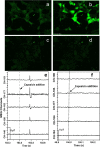Measuring Cellular Ion Transport by Magnetoencephalography
- PMID: 32149229
- PMCID: PMC7057328
- DOI: 10.1021/acsomega.9b03589
Measuring Cellular Ion Transport by Magnetoencephalography
Abstract
The cellular-level process of ion transport is known to generate a magnetic field. A noninvasive magnetoencephalography (MEG) technique was used to measure the magnetic field emanating from HeLa, HEK293, and H9c2(2-1) rat cardiac cells. The addition of a nonlethal dose of ionomycin to HeLa and capsaicin to TRPV1-expressing HEK293 cells resulted in a sudden change in the magnetic field signal consistent with Ca2+ influx, which was also observed by confocal fluorescence microscopy under the same conditions. In contrast, addition of capsaicin to TRPV1-expressing HEK293 cells containing an optimum amount of a TRPV1 antagonist (ruthenium red), resulted in no detectable magnetic or fluorescent signals. These signals confirmed that the measured MEG signals are due to cellular ion transport through the cell membrane. In general, there is evidence that ion channel/transporter activation and ionic flux are linked to cancer. Therefore, our work suggests that MEG could represent a noninvasive method for detecting cancer.
Copyright © 2020 American Chemical Society.
Conflict of interest statement
The authors declare no competing financial interest.
Figures




Similar articles
-
Mechanism of capsaicin receptor TRPV1-mediated toxicity in pain-sensing neurons focusing on the effects of Na(+)/Ca(2+) fluxes and the Ca(2+)-binding protein calretinin.Biochim Biophys Acta. 2013 Jul;1833(7):1680-91. doi: 10.1016/j.bbamcr.2012.08.018. Epub 2012 Sep 5. Biochim Biophys Acta. 2013. PMID: 22982061
-
Quantitative characterization of capsaicin-induced TRPV1 ion channel activation in HEK293 cells by impedance spectroscopy.Anal Bioanal Chem. 2016 Nov;408(29):8529-8538. doi: 10.1007/s00216-016-9978-x. Epub 2016 Oct 8. Anal Bioanal Chem. 2016. PMID: 27722942
-
Measurement of relative Ca²⁺ permeability during sustained activation of TRPV1 receptors.Pflugers Arch. 2016 Feb;468(2):201-11. doi: 10.1007/s00424-015-1741-1. Epub 2015 Oct 21. Pflugers Arch. 2016. PMID: 26490461
-
Transient receptor potential vanilloid 1 (TRPV1)-independent actions of capsaicin on cellular excitability and ion transport.Med Res Rev. 2023 Jul;43(4):1038-1067. doi: 10.1002/med.21945. Epub 2023 Mar 14. Med Res Rev. 2023. PMID: 36916676 Review.
-
Differential effects of TRPV channel block on polymodal activation of rat cutaneous nociceptors in vitro.Exp Brain Res. 2009 Jun;196(1):31-44. doi: 10.1007/s00221-009-1808-3. Epub 2009 Apr 30. Exp Brain Res. 2009. PMID: 19404626 Review.
Cited by
-
Calcium Entry through TRPV1: A Potential Target for the Regulation of Proliferation and Apoptosis in Cancerous and Healthy Cells.Int J Mol Sci. 2020 Jun 11;21(11):4177. doi: 10.3390/ijms21114177. Int J Mol Sci. 2020. PMID: 32545311 Free PMC article. Review.
References
LinkOut - more resources
Full Text Sources
Miscellaneous
